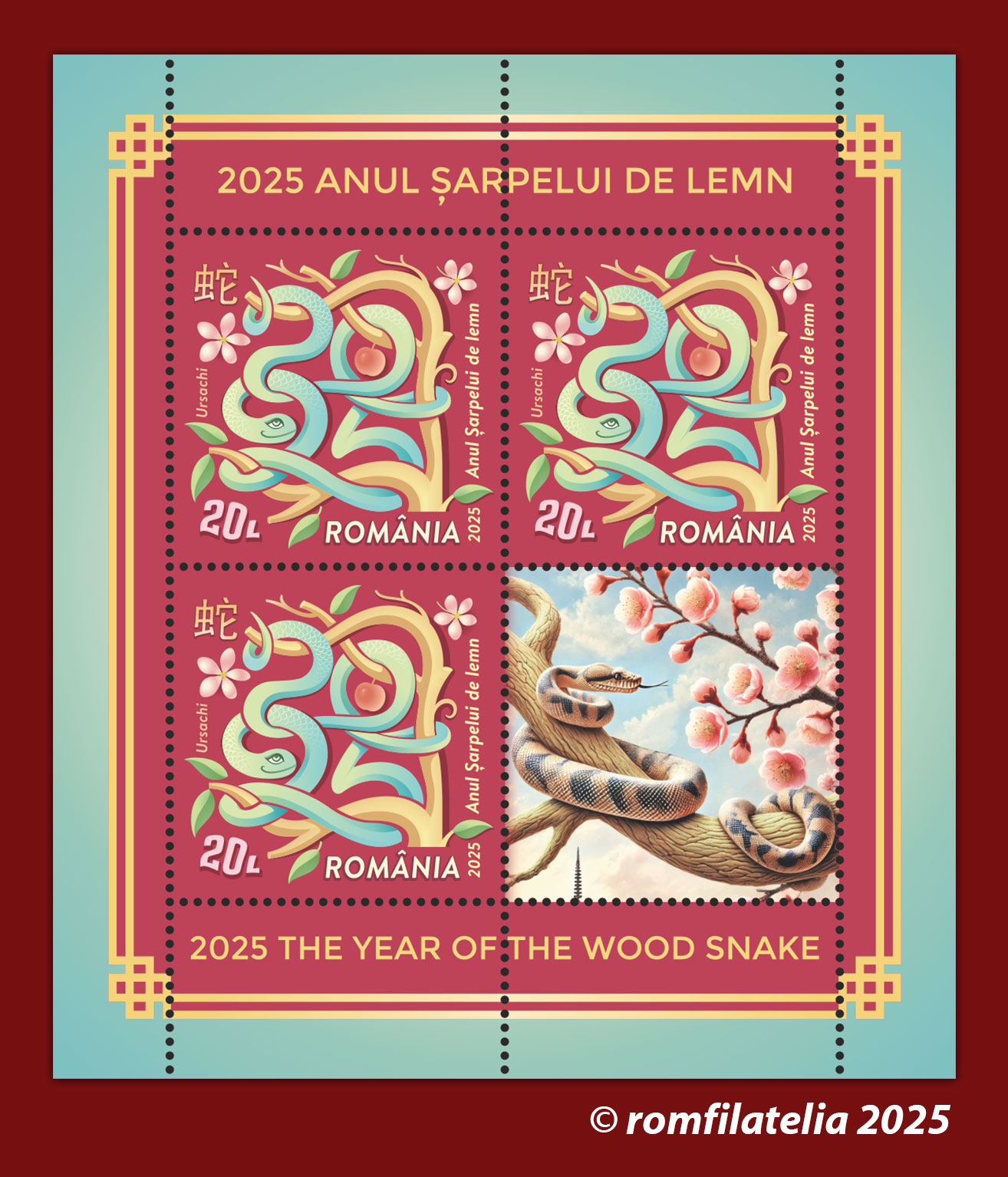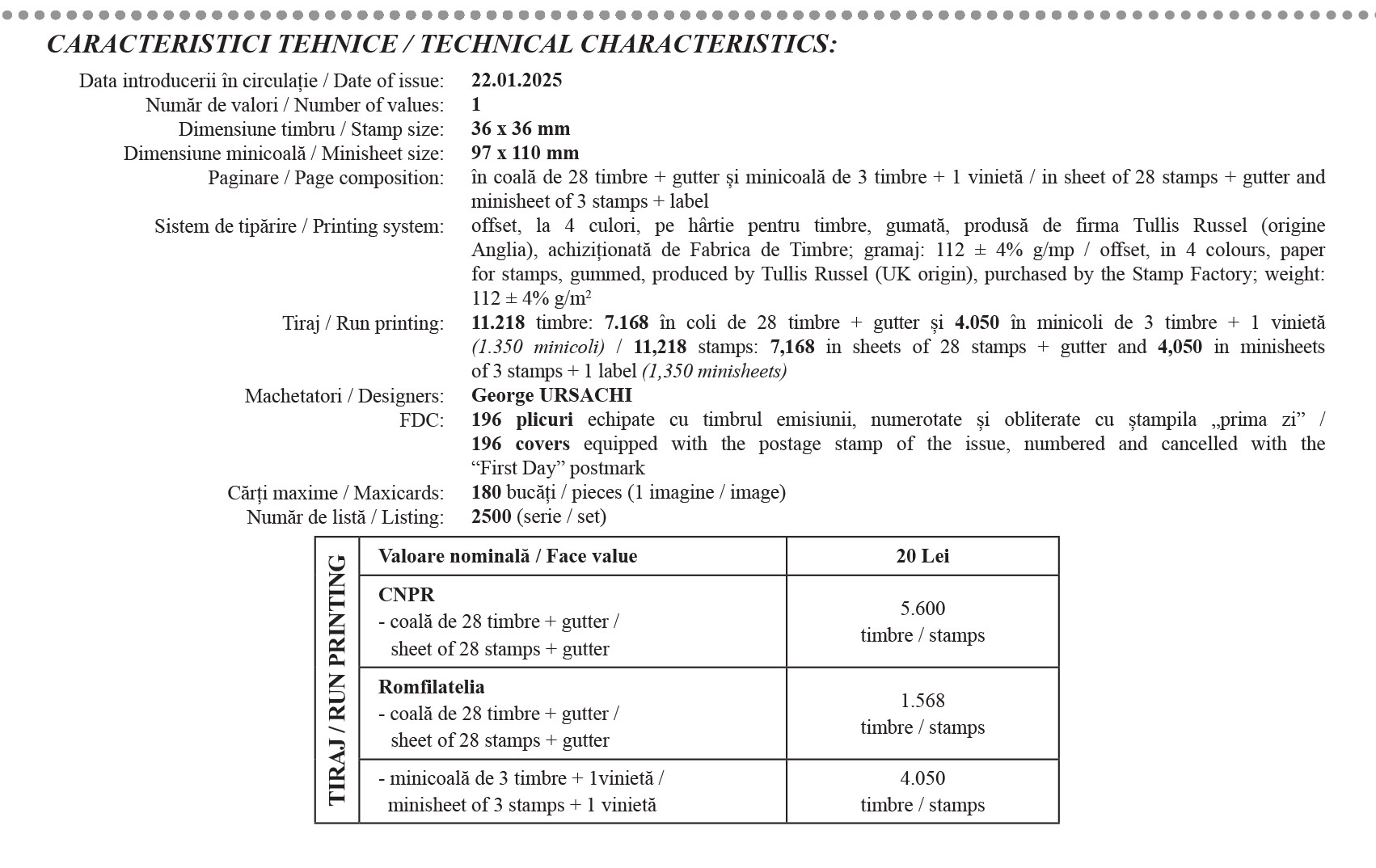 Romfilatelia introduces into circulation on Wednesday, January 22nd, 2025, an issue dedicated to the Chinese Zodiac and New Year under the general name: Year of the Wood Snake, consisting of a postage stamp, a First Day Cover and a maxicard for the maximaphily enthusiasts.
Romfilatelia introduces into circulation on Wednesday, January 22nd, 2025, an issue dedicated to the Chinese Zodiac and New Year under the general name: Year of the Wood Snake, consisting of a postage stamp, a First Day Cover and a maxicard for the maximaphily enthusiasts.
Used for over three thousand years, the Chinese Zodiac precedes European astrology. The concept of this zodiacal system has become a formidable concept compared to that of the West when it comes to defining people’s character. Unlike astrology, whose predictions are based on the position of the Sun, stars, and planets, the Chinese calendar, based on the phases of the moon, assigns the name of an animal to each year of a 12-year cycle. It is accepted that each of the 12 animals has the ability to endow the person born under that sign with certain qualities.
The year 2025 is associated with the ‘Wood Snake’, with the Chinese New Year starting on January 29th and ending on February 16th, 2026. It is noteworthy that the element ‘wood’ is associated with flexibility and renewal. Positioned in the middle of the Chinese Zodiac (the sixth sign), the snake is regarded as a manifestation of intelligence, mystery, and introspection. It is not only a symbol of rebirth and renewal but also a seeker of new beginnings and new paths, leaving the past behind.
The snake, a fascinating animal due to its characteristic of shedding its skin, symbolically suggests the ability to regenerate and transform. Natives of this zodiac sign have an extraordinary capacity for resilience, adaptability, and the ability to reinvent and transform themselves throughout life. In folklore and mythological tradition, it is seen as a manifestation of wisdom, deep knowledge, and subtle strength. Natives of the Wood Snake sign are those born in the years: 1917, 1929, 1941, 1953, 1965, 1977, 1989, 2001, 2013, and, of course, the natives of the year 2025.
The Chinese New Year, which begins with the first day of the Wood Snake, also known as the Year of the Green Snake, having as the main attraction the Festival of Colored Lanterns, represents an event of great importance and emotion. Windows and doors of homes, decorated with stylized red paper elements, display texts related to popular themes such as happiness, wealth, and longevity. The meal served on New Year’s Eve typically includes pork, duck, or chicken, followed by a sweet dessert. The evening ends with fireworks
Chinese Zodiac astrologers make a few predictions for the natives of the Snake sign: lucky numbers: 2, 8, 9 or combinations, lucky colours: black, red, yellow, and lucky flowers: orchids and cacti.
Between January 29th, 2025, and February 16th, 2026, according to predictions, everyone will borrow from the wisdom of the Wood Snake and focus on personal development. It is a year of growth, evolution, and major resolutions.
However, we must also take into account the fact that although the Snake displays wisdom, intelligence, creativity, and intuition, being associated with luck, prosperity, and rebirth, it may also have a darker side that reveals deception, jealousy, and temptations.
In conclusion, with optimism, let us consider the essence of the predictions: although they may find themselves caught in the midst of unforeseen changes, the natives of the Snake will manage to move forward wisely, overcoming undesirable situations. Their flexibility and negotiation skills will help them strengthen their position.
The postage stamp with the face value of Lei 20, presents, in a specially designed graphic, a snake outlining the numbers indicating the year 2025, in a green shade (justified by the name Green Snake). The wooden branches in the composition conceal an apple, alluding to the fact that, in the Christian concept, the snake is also an element of evil (the one who tempted Eve to eat the fruit from the forbidden tree).
The design of the First Day Cover graphically presents the symbol of the sign of the Wood Snake, associating the trunk of a tree adorned with the green of the leaves on which a snake is coiled with the fabric of scales that
display various patterns, found in folk costumes or some elements of home decoration.



